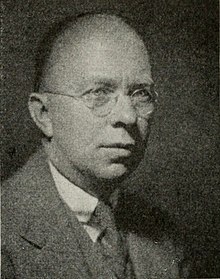
Karl Kelchner Darrow (November 26, 1891 – June 7, 1982) was an American physicist and secretary of the American Physical Society from 1941 to 1967.
Biography
Darrow was born on November 26, 1891, in Chicago, Illinois. He received his PhD from the University of Chicago under Robert A. Millikan in 1917. Darrow spent his working career at Western Electric from 1917 and then Bell Laboratories from its founding in 1925 until his retirement in 1956. He wrote four books and over 200 technical articles, histories, and critical reviews for professional journals, many of them in the Bell System Technical Journal. Darrow was a nephew of the famed trial attorney Clarence Darrow.
Darrow was elected to the American Philosophical Society in 1936.
In his book Atomic Energy (1948), which contains four lectures he had given in 1947, he points out that in reality his subject is nuclear energy, but that at the time of the bombing of Hiroshima someone wrote of it as an atomic bomb, and the misusage spread "like a chain reaction". The book includes the following passage:
Here is the climax of my lectures, and here is where you should be frightened; and if I had an orchestral accompaniment, here is where the orchestra would have mounted to a tumultuous fortissimo, with the drums rolling and the trumpets blaring and the tuba groaning and the strings in a frenzy, and whatever else a Richard Wagner could contrive to cause a sense of Gotterdammerung; for, let there be no doubt of it, this is something that could bring on the twilight of civilization. But at this crucial juncture I have only words to serve me, and all the words are spoiled. We speak of an awful headache, a dreadful cold, a frightful bore, and an appalling storm; and now when something comes along that is really awful and dreadful and frightful and appalling, all these words have been devaluated and have no terror in them. I have to fall back on the saying, of unknown origin and dubious value, that the strongest emphasis is understatement. Let then this picture, with its circles and its symbols and its numbers, be considered an emphatic understatement of the most terrific thing yet known to man.
Darrow was elected to the American Academy of Arts and Sciences in 1964.
Darrow died on June 7, 1982, in New York City.
Bibliography
- Introduction to Contemporary Physics, 1926
- Electrical Phenomena in Gases, 1932
- The Renaissance in Physics, MacMillan, 1936
- Atomic Energy, 1948
References
- "APS Member History". search.amphilsoc.org. Retrieved 2023-05-30.
- "Abstracts of Technical Articles by Bell System Authors". Bell System Technical Journal. 28 (1): 159. January 1949.
- "Karl Kelchner Darrow". American Academy of Arts & Sciences. 2023-02-09. Retrieved 2023-05-30.
External links
- Obituary in Physics Today November, 1982
- Oral history interview transcript with Karl Darrow on 2 April 1964, American Institute of Physics, Niels Bohr Library & Archives - Session I
- Oral history interview transcript with Karl Darrow on 10 June 1964, American Institute of Physics, Niels Bohr Library & Archives - Session II
- Biography and archive of Darrow papers at Niels Bohr Library & Archives
Archival collections
- Darrow photo collection, Emilio Segrè Visual Archives, Niels Bohr Library & Archives
- Karl K. Darrow papers, 1872-1978 (bulk 1917-1972), Niels Bohr Library & Archives